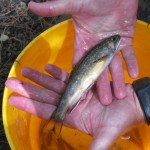 Mother bear with three small cubs seen April 24 and 25 in the Dunster Drive neighborhood adjacent to Mink Brook. Thanks to a neighbor for this shot (through a screen door). Mink Brook neighbors should befriend the bears by bringing in birdfeeders, securing their trash, and controlling their dogs. Mother bears are very protective parents.
Mother bear with three small cubs seen April 24 and 25 in the Dunster Drive neighborhood adjacent to Mink Brook. Thanks to a neighbor for this shot (through a screen door). Mink Brook neighbors should befriend the bears by bringing in birdfeeders, securing their trash, and controlling their dogs. Mother bears are very protective parents.
Woodcock Walk & Talk
Woodcock are singing as part of their mysteriously elaborate aerial displays. Find out more about them and how to manage land for ideal woodcock habitat on April 13. More
Trails Softening ~ Bears Out Soon!
This week’s unusually warm temperatures mean muddy trails. It’s best to stay off the trails until they dry out and harden up. An exception is the Quinn Trail at Mink Brook Nature Preserve.
Time to bring in your bird feeders! State biologists expect the bears weren’t fooled by this mild winter any more than we were, and ask that you bring in your bird feeders now, and don’t wait until April 1.
Marshall Brook Wetlands Trip Feb. 25
On Feb. 25, we explored this extensive wild area in the northeast corner of Hanover with naturalist Alcott Smith, and found fresh bobcat tracks and a beaver mansion, among many other discoveries. Take the tour (through the lens of Jim Block’s camera) here!
Greensboro Ridge Discoveries Revealed
Biologists John Severance and Elise Lawson of Watershed to Wildlife, Inc. shared their discoveries at the Greensboro Ridge Natural Area on Jan. 23 at the Howe Library. We asked them to inventory natural resources on our 113-acre preserve and to tell us what they found. An unusual saxifrage swamp…fisher stalking porcupine…richly productive vernal pools, and more.
Wild Brook Trout at Mink Brook
The Mink Brook watershed, Hanover’s largest, harbors healthy populations of wild brook trout, even in some of its smallest tributaries. Fisheries biologists from New Hampshire’s Fish and Game Department, working with volunteers from Trout Unlimited, the Conservancy’s Mink Brook Stewardship Committee, and Hanover students conducted a thorough study of the Mink Brook watershed in July, 2011.

The study is part of the Eastern Brook Trout Joint Venture, a region-wide effort looking at habitat for wild brook trout. At Mink Brook, biologists examined details of each section’s habitat characteristics, measured water temperature, and recorded the length, weight, and species of each fish captured. Fish were “borrowed” from the water by electro-fishing – a wand sending a weak electric current through the water temporarily stuns the fish, which can then be scooped up with a net and transferred to a bucket for study. All fish were returned to the brook after their brief examination.
Mink Brook is among the streams under study by Dartmouth for survival of young Atlantic salmon, and a number of young salmon turned up.
- « Previous Page
- 1
- …
- 8
- 9
- 10




